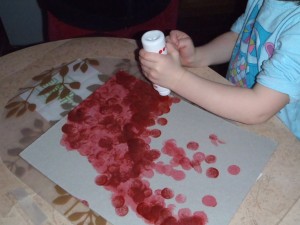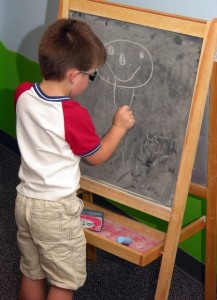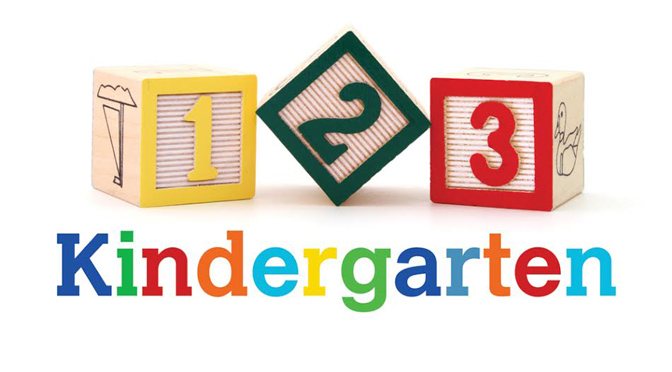Every occupation and career has its own set of tools and play is children’s work; for kids early learning tools include sticks, rocks, mud, and toys, as well as crayons, chalk, glue, and scissors. Letting your child play and experiment with these tools is not just fun, it’s also helpful before starting kindergarten or preschool. Being familiar with them increases a child comfort and confidence and fine motor skills.
 To minimize the chance of walls or carpets being given a new color, it’s a good idea to crayon or glue proof an area. Big markers, crayons, and paint brushes are easier to hold than thinner ones. Paint dabbers are super handy as the color comes premixed with the sponge attached, but anything from q-tips to branches can be used. There are hundreds of recipes for homemade paint that vary from food colors diluted with water to instant pudding. (The pudding option is great for encouraging kids who are not particularly interested in drawing.)
To minimize the chance of walls or carpets being given a new color, it’s a good idea to crayon or glue proof an area. Big markers, crayons, and paint brushes are easier to hold than thinner ones. Paint dabbers are super handy as the color comes premixed with the sponge attached, but anything from q-tips to branches can be used. There are hundreds of recipes for homemade paint that vary from food colors diluted with water to instant pudding. (The pudding option is great for encouraging kids who are not particularly interested in drawing.)
 Glue ranges from ordinary to sparkles to glow-in-the-dark. Paper can be recycled from cereal boxes, newsprint, and wrapping paper. Besides chalk boards, driveways, sidewalks and patios expand the space to giant-size. Scissors are the most challenging tool to use. Playdough is easy to cut, doesn’t have any lines to follow, and can be cut over and over. As hands roll, pat, squish, and smoosh, they get lots of exercise.
Glue ranges from ordinary to sparkles to glow-in-the-dark. Paper can be recycled from cereal boxes, newsprint, and wrapping paper. Besides chalk boards, driveways, sidewalks and patios expand the space to giant-size. Scissors are the most challenging tool to use. Playdough is easy to cut, doesn’t have any lines to follow, and can be cut over and over. As hands roll, pat, squish, and smoosh, they get lots of exercise.
The small muscles in the hand and wrist are still developing at this age. Strength and coordination will depend a great deal on how much kids have been able to play with learning tools and other toys, as well as their own unique strengths and challenges. Some kids are eager to use them and others are hesitant or not interested. Learning tools also give children a chance to be creative. Besides the physical opportunities, kids also practice problem-solving, planning, making choices, using language and other skills. Are there some learning tools for your child’s play–and work?
